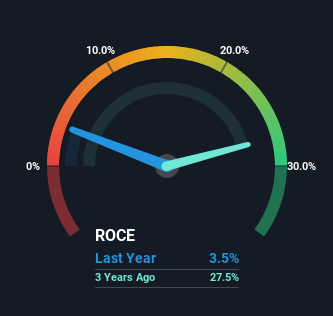- Germany
- /
- Marine and Shipping
- /
- XTRA:HLAG
Investors Could Be Concerned With Hapag-Lloyd's (ETR:HLAG) Returns On Capital

To find a multi-bagger stock, what are the underlying trends we should look for in a business? Firstly, we'll want to see a proven return on capital employed (ROCE) that is increasing, and secondly, an expanding base of capital employed. Put simply, these types of businesses are compounding machines, meaning they are continually reinvesting their earnings at ever-higher rates of return. Having said that, from a first glance at Hapag-Lloyd (ETR:HLAG) we aren't jumping out of our chairs at how returns are trending, but let's have a deeper look.
Return On Capital Employed (ROCE): What Is It?
If you haven't worked with ROCE before, it measures the 'return' (pre-tax profit) a company generates from capital employed in its business. Analysts use this formula to calculate it for Hapag-Lloyd:
Return on Capital Employed = Earnings Before Interest and Tax (EBIT) ÷ (Total Assets - Current Liabilities)
0.035 = €821m ÷ (€30b - €6.3b) (Based on the trailing twelve months to June 2024).
So, Hapag-Lloyd has an ROCE of 3.5%. Ultimately, that's a low return and it under-performs the Shipping industry average of 11%.
See our latest analysis for Hapag-Lloyd

In the above chart we have measured Hapag-Lloyd's prior ROCE against its prior performance, but the future is arguably more important. If you'd like to see what analysts are forecasting going forward, you should check out our free analyst report for Hapag-Lloyd .
So How Is Hapag-Lloyd's ROCE Trending?
When we looked at the ROCE trend at Hapag-Lloyd, we didn't gain much confidence. Around five years ago the returns on capital were 5.8%, but since then they've fallen to 3.5%. Given the business is employing more capital while revenue has slipped, this is a bit concerning. This could mean that the business is losing its competitive advantage or market share, because while more money is being put into ventures, it's actually producing a lower return - "less bang for their buck" per se.
In Conclusion...
We're a bit apprehensive about Hapag-Lloyd because despite more capital being deployed in the business, returns on that capital and sales have both fallen. Since the stock has skyrocketed 283% over the last five years, it looks like investors have high expectations of the stock. In any case, the current underlying trends don't bode well for long term performance so unless they reverse, we'd start looking elsewhere.
Hapag-Lloyd does have some risks, we noticed 2 warning signs (and 1 which is a bit unpleasant) we think you should know about.
For those who like to invest in solid companies, check out this free list of companies with solid balance sheets and high returns on equity.
Valuation is complex, but we're here to simplify it.
Discover if Hapag-Lloyd might be undervalued or overvalued with our detailed analysis, featuring fair value estimates, potential risks, dividends, insider trades, and its financial condition.
Access Free AnalysisHave feedback on this article? Concerned about the content? Get in touch with us directly. Alternatively, email editorial-team (at) simplywallst.com.
This article by Simply Wall St is general in nature. We provide commentary based on historical data and analyst forecasts only using an unbiased methodology and our articles are not intended to be financial advice. It does not constitute a recommendation to buy or sell any stock, and does not take account of your objectives, or your financial situation. We aim to bring you long-term focused analysis driven by fundamental data. Note that our analysis may not factor in the latest price-sensitive company announcements or qualitative material. Simply Wall St has no position in any stocks mentioned.
About XTRA:HLAG
Flawless balance sheet with solid track record and pays a dividend.
Similar Companies
Market Insights
Community Narratives



